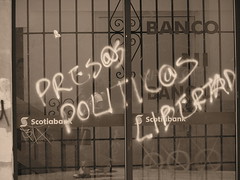Vanity Fairing
Included on our packing list for travel to Mexico was the October Vanity Fair, a subscription we've enjoyed this year as a gift from our sister-in-law Wendy. So even as the volume of the movie on the 8 hour bus ride from Mexico City to Oaxaca (everybody agrees it only takes 5 1/2 or 6 but we've yet to experience such a short ride) overpowered us I was able to get my fix of glossy fashion ads and haute couture.
One reason I really like Vanity Fair is for the political reporting, and the October issue is no exception. I realize the month is nearly spent and, periodicals existing in the perennial race for readers that they do, Christmas editions will be on newsstands shortly. That aside, let me direct your attention to a pair of articles that are well worth reading.
The first, Todd Purdum's "Inside Bush's Bunker," is a thorough look at what goes into making the White House arguably one of the most secure installations on the planet. The bunker in question, however, is every bit as much mental, emotional and intellectual as it is physical. Purdum, through interviews, accounts and, by necessity, a bit of informed speculation, offers a peek inside what could be characterized as the most media unfriendly and closed-minded administration this side of Iran. For an idea of how the President gets his information and whom he trusts for pushback or outside ideas (nearly no one, and trusting and listening to are two different things) this article is a must read.
I have not yet finished reading "Billions Over Baghdad," but the content is scandalous, or would be if as a citizenry we could just quit caring about whether Paris is in jail or Britney has her kids for the night. Here Donald Bartlett and James Steele investigate how, from start to finish, the Coalition Provisional Authority (I last blogged on the CPA here) arranged for nearly 12 billion dollars in US cash money--literally 363 tons--to be withdrawn from the Federal Reserve and airlifted to Baghdad from 2003-2004. More than $9 billion of that has since "gone missing" with no one to account for it. And not theoretical money, money on paper or electronic funds. We're talking about tangible bills, ones, fives, tens, twenties and hundreds with the likenesses of dead white men on the faces and the seal of the US government on their backsides. The authors point to croneyism from the Pentagon and the White House, confusion as to how the CPA was mandated and to whom it answered*, a compliant and increasingly bamboozled Congress, and a breathtaking lack of concern about what the money actually went for, as reasons why it was so easy for anybody with open hands to capture what may have been the real loot of the Iraq War.
So there you have it, my plug for print media for the month. Check it out online (free) or go to the library for an afternoon of reading (also free) or get your hands on a rumpled and dog-eared copy from the beauty salon or motor vehicle office (we wish!) and don't let it go until you've read these articles about the people in charge of our country today.
*Sidenote: the CPA apparently answered to nobody. The article points out that the Coalition Provisional Authority, in actuality, was neither a US government agency nor a UN body nor an Iraqi entity). In essence the CPA mandated, approved and oversaw the CPA, and in the confusion of post-invasion Iraq that was enough for the world.



|